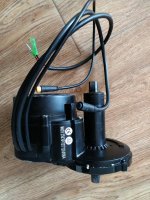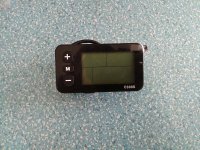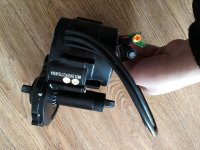jur said:
I bought a 48V/500W TSDZ2 from @eyebeyesickle and installed it this weekend on my wife's Moulton APB. I have a BBS02 on my Moulton APB.
My BBS02's original firmware settings have been completely reconfigured; the original settings were frankly awful - various PAS levels had not only power levels associated, but speed limits as well which was for my type of cycling really totally useless. I am a reasonably strong rider; I wanted a bad weather bike and the Moulton APB with its full suspension is ideal for the mid motor conversion, making all extra weight fully suspended. So I configured it to just give increasing power levels for each PAS level, but no speed limits anywhere. The result is the natural bicycle feel is retained; the difference is that the riding becomes a little easier, as if a you have strong tailwind: Slight uphills become level, level becomes a slight downhill, and headwinds disappear. The pedalling still feels almost exactly as before, just a little easier, or much easier if I pick a higher power level. So I get a constant power added to whatever I am pedaling.
The TSDZ2, on the other hand, is very nice with the progressive power added as I put more torque on the pedals. Earlier reports in this thread said that the torque sensor is more like an on-off switch, but I can verify it's a proper proportional torque added to what I pedal. A real torque multiplier.
Overall, I think my programming of the BBS02 is more "bicycle-like" than the TSDZ2; but the variable power added to my effort from the TSDZ2 is very handy too. In some cases the BBS02 would be better, for example when I feel tired, I can ease off my own effort but the BBS02 keeps giving the same. On the TSDZ2 that effort would be dialed down too, perhaps necessitating selecting a higher level of torque multiplication.
TSDZ2 also has a PAS in addition to the torque sensor, with that it should do "human power" algorithm that is output = pedal cadence * pedal torque.
With our OpenSource firmware, we will be able to implement PAS mode only, by ignoring the torque signal - that is another advantage of developing our own firmware.
To say the true, my little son 7 years old ebike has a bottom bracket torque sensor but I ended up to configure our firmware to run PAS mode so is like what you describe - which is much easier for him to ride the ebike.
BUT, since our firmware mixes torque and PAS signals (uses the max value of both), at startup the torque sensor signal is higher and he gets the motor help as if is a torque sensor and after having cadence, the cadence value will be higher than torque and system works like PAS only. This is a unique feature we could implement on TSDZ2, having the best of both worlds: torque sensor (for startup) + PAS.
I am blocked on developing the firmware for TSDZ2 because there are some math advanced trigonometry to get motor run very efficient and silent, which I didn't figure yet. If someone could help on this....
jur said:
On the TSDZ2 that effort would be dialed down too, perhaps necessitating selecting a higher level of torque multiplication.
I see, using torque sensor just like a trigger, min value of torque sensor could output a constant torque to the motor. Again, totally possible but only if we develop it.




